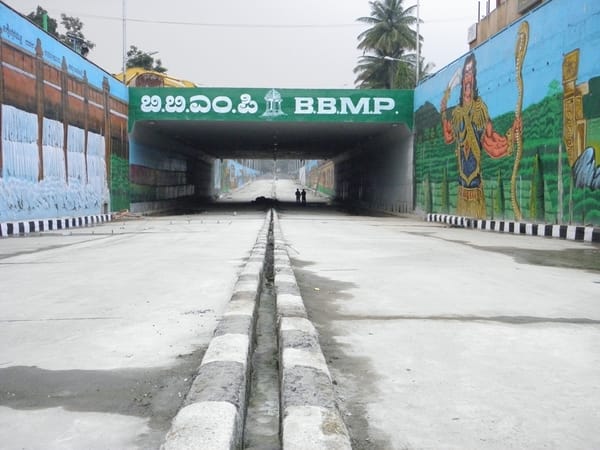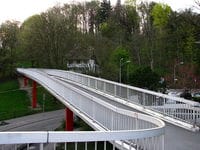With rapidly growing vehicular numbers, traffic congestion in Bangalore seems unmanageable. Pedestrians, particularly senior citizens and physically challenged persons, are facing grave problems. Walking on the footpaths has become hazardous and an almost impossible task, due to narrow, uneven footpaths, footpaths littered with debris, garbage, vendors and in several cases non-existent! The only alternative is to walk on the roads, risking one’s life. And, crossing the roads, especially with heavy traffic, is an adventure, few would dare attempt.
To address the problem of increasing vehicular traffic, BDA, BBMP etc., understandably, focuses on widening roads, constructing flyovers and underpasses etc. This may increase driving comfort and reduce vehicular traffic problems, but indicates reduced concern for pedestrians.

JP Nagar’s 15th Cross underpass. Riddled with issues. File Pic: Yogaraj S Mudalgi
Bruhat Bangalore Mahanagara Palike and other authorities are attempting to address this problem by constructing foot over bridges (sky walks) and pedestrian underpasses. Unfortunately, both these are planned, designed and executed extremely badly and at enormous cost. Consequently, they have failed the very purpose for which they were constructed, for the following reasons:
Pedestrian over bridges
Physically challenged persons, people in wheelchairs, senior citizens, children and expectant women cannot use foot over bridges and underpasses easily, due to the number stairs they have. Only able bodied persons can climb these high and numerous steps. These over bridges also contravene Chapter VIII, Non-Discrimination, Section 44 and 45 of “THE PERSONS WITH DISABILITIES (EQUAL OPPORTUNITIES, PROTECTION OF RIGHTS AND FULL PARTICIPATION) Act 1995.
Effectively, many citizens cannot use these over bridges. The foot over bridges on Palace Road near Sophia School (with 65 steps each way, reportedly) and Maharani’s College Circle are prime examples of badly designed public infrastructure.
Providing escalators or lifts as proposed near Majestic Circle, supposedly to solve the problem, are other examples of bad planning. Considering high pedestrian volumes, elevators can cope only with a capacity of at least 50 persons or more per lift. Escalators also pose similar problems. Importantly, it will be impossible for physically challenged persons and people in wheelchairs to use them. With frequent power cuts, the state of people in lifts or escalators is easy to imagine, during power failure! And in this scenario, BBMP proposes to construct 100 foot over bridges or skywalks cost Rs. 1.5 crores each totaling 150 crores.
Pedestrian Underpasses
Skywalks should be well designed. Pic: Wikimedia Commons.
A solution to the skywalk problem is to provide well planned, designed and executed underground pedestrian crossing. BBMP has constructed several of these but they are not being used only because they are badly designed. Notable examples are the underpasses in KR Circle and 5th Cross, Malleswaram. Following are the challenges with underpasses:
- Steps at the entrance block senior citizens and physically challenged persons in wheelchairs
- Narrow, dark and poor maintenance
- Fear of sexual assault and rowdy elements make them unsafe for women
- Usage as urinals
- Mugging, pick pocketing and chain snatching in the dark passages
- Vendors spreading their wares in the passage obstructively
Pedestrian underpasses abroad (in photographs below), are excellent examples of well designed and executed underpasses. These designs are user friendly, brightly lit and with ramps on which wheelchairs can move easily and comfortably. Persons of all age groups can use them. Sufficient light and safety in these underpasses, will encourage more people to use them. They are also easy to maintain. BBMP and BDA have adequate well qualified architects, structural engineers and contractors in both the private sector and government whose expertise does not seem to be utilized, unfortunately.
Community participation in design, construction and maintenance of underpasses will provide incentives for people to use them. It will make them safer and cleaner. Residents’ Welfare Associations (RWAs) can play an important role in these underpasses, particularly in maintenance. Traders, shopkeepers and business houses can be involved in designing and constructing these underpasses, either on an individual or PPP basis, which will save BBMP some financial burden. Materials of good quality and lighting will be incentives to business houses to advertise their products and encourage them to participate actively in this enterprise. Some bus shelters built in Bangalore, which are well designed and maintained by business houses, where their products are advertised, are examples.
Pedestrian Traffic Lights
An inexpensive and quick alternative to pedestrian underpasses and foot bridges, are manually operated or automatic light signals at traffic intersections, which are available in many countries. These greatly help persons with different types of disabilities like the wheel chair bound or visually challenged and those who can not use foot over bridges or underpasses. Synchronized signal system should be installed on long stretches of arterial roads. In fact, such traffic lights installed in a few locations in Bengaluru, are very effective and should be replicated widely on a priority.
Paved Pedestrian Humps
Broad, raised (6″ high) and paved pedestrian crossings, which are presently constructed as road humps, are an effective, economical and practical solution to pedestrian crossings. Prominent signboards indicating a physically challenged person in a wheelchair will slow down/stop vehicles and help pedestrians to cross roads safely.
BBMP, BDA and the PWD should install these traffic lights or pedestrian crossings on top priority to provide immediate relief to the pedestrian. Simultaneously, these bodies should strive to build underpasses with better design and construction procedures, which pedestrians can use safely and comfortably.⊕

A promising headline article, very loud on complaining and whining, but very short on substance and solutions.
We know BBMP wastes crores of money on badly designed skywalks, but Mr. Sirur offers no alternative design other than saying foreign countries have good skywalks. Having lived over 20 years in the US and Singapore, many of those “good” skywalks do not exist. Just taking a photo from Wikipedia does not help Sir. Show us a design.
While very loudly proclaiming violations and sections, this article forgets to mention that the skywalks are constructed at a ridiculous height of 5 mtr+ due to requirements of the Indian Roads Congress. One just has to observe BMTC buses which are only half the height of the skywalk.
May be the RWA of Malleswaram can propose an alternate design of the equally poor skywalk at IISc and lead the way.
Citizen Matters, the time has come to stop whining and instead become a platform for solutions.
Otherwise we will forever remain monkeys with the “banana”. Yeh banana hai, woh sochna hai ……. Yella Madu Beku. Yenu madaithu? Onde illa.